RBSE Solutions for Class 12 Maths Chapter 13 Probability Ex 13.5
Rajasthan Board RBSE Solutions for Class 12 Maths Chapter 13 Probability Ex 13.5 Textbook Exercise Questions and Answers.
Rajasthan Board RBSE Solutions for Class 12 Maths in Hindi Medium & English Medium are part of RBSE Solutions for Class 12. Students can also read RBSE Class 12 Maths Important Questions for exam preparation. Students can also go through RBSE Class 12 Maths Notes to understand and remember the concepts easily.
RBSE Class 12 Maths Solutions Chapter 13 Probability Ex 13.5
Question 1.
A die is thrown 6 times. If getting an odd number is a success, what is the probability of:
(i) 5 successes?
(ii) at least 5 successes?
(iii) at most 5 successes?
Answer:
The repeated tosses of a die are Bernoulli trials. Let X denote the number of successes of getting odd numbers in an experiment of 6 trials.
Probability of getting an odd number in a single throw of a die is, p = \(\frac{3}{6}=\frac{1}{2}\)
∴ q = 1 - p = \(\frac{1}{2}\)
X has a binomial distribution.
Therefore, P (X = x) = 0Cn-rq px, where n = 0, 1,2 ..... n
= \({ }^n C_x\left(\frac{1}{2}\right)^{6-x} \cdot\left(\frac{1}{2}\right)^x={ }^n C_x\left(\frac{1}{2}\right)^6\)
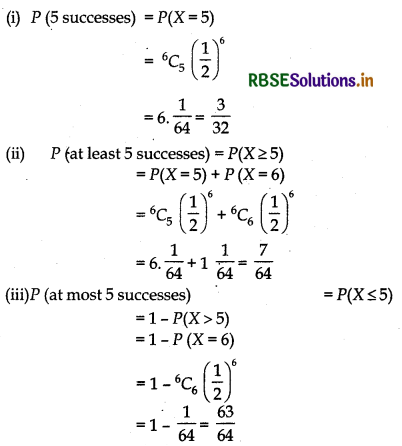
Qudestion 2.
A pair of dice is thrown4times. If getting doublet is considered a success, find the probability of two successes.
Answer:
Answer:
The repeated tosses of a pair of dice are Bernoullitrials. Let X denote the number of times of getting doublets in an experiment of throwing two dice simultaneously four times.
Probability of getting doublets in a single throw of the pair of dice is
p = \(\frac{6}{36}=\frac{1}{6}\)
∴ q = 1 - p = 1 - \(\frac{1}{6}=\frac{5}{6}\)
Clearly , X has the binomial distribution with n = 4,
p = \(\frac{1}{6}\), and q = \(\frac{5}{6}\)
∴ P(X = x)nCx qn - x px, where x = 0, 1, 2, 3 ....... n


Question 3.
There are 5% defective items in a large bulk of items. What is the probability that a sample of 10 times will include not more than one defective item?
Answer:
Let X denote the number of defective items in a sample of 10 items drawn successively. Since the drawing is done with replacement, the trials are Bernoulli trials.
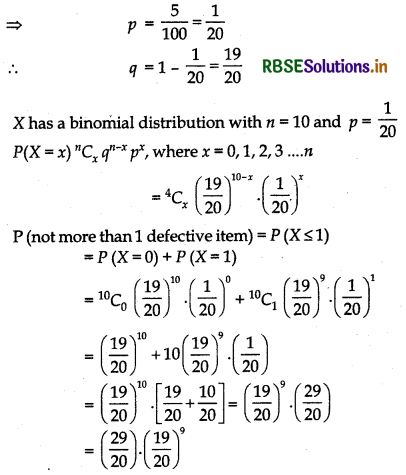
Question 4.
Five cards are drawn successively with replacement from a well-shuffled deck of 52 cards. What is the probability that
(i) all the five cards are spades?
(ii) only 3 cards are spades?
(iii) none is a spade?
Answer:
Let X represent the number of spade cards among the five cards drawn. Since the drawing of card is with re placement, the trials are Bernoulli trials.
In a well shufflied deck of 52 cards, there are 13 spade cards.
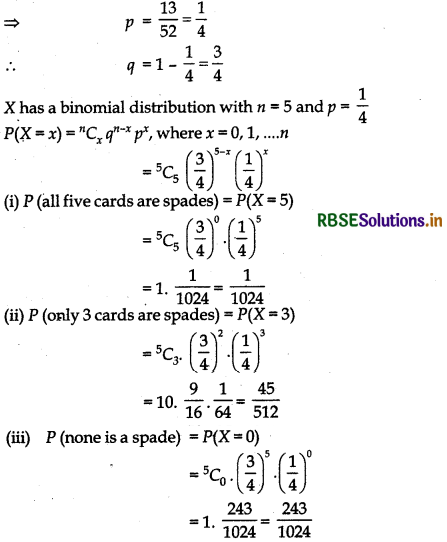
Question 5.
The probability that a bulb produceed by a factory will fuse after 150 days of use is 0.05. Find the probability that out of 5 such bulbs
(i) none
(ii) not more than one
(iii) more than one
(iv) at least one will fuse after 150 days of use.
Answer:
Let X represent tÍe number of bulbs that will fuse after 150 days of use in an experiment of 5 trials. The trials are Bernoulli trials.
It is given that, p = 0.05
∴ q = 1 - p = 1 = 1 - 0.05 = 0.95
X has a binomial distribution with n = 5 and p = 0.05
p(X = x) nCxqn - xpx, where x = 1, 2, ....... n
= 5Cx (0.95)5 - x.(0.05)x
(i) P (none) = P (X = 0)
= 5Cx (0.95)5 (0.05)0
= 1 × (0.95)5
= (0.95)5
(ii) P (not more than one) = P(X ≤ 1)
= P(X = O) + P (X = 1)
= 5C0 (0.095)5 × (0.05)0 + 5C1 (0.95)4 × (0.05)1
= 1 × (0.95)5 + 5 × (0.95)4 × (0.05)
= (0.95)5 × (0.25) (0.95)4
= (0.95)4 [0.95 + 0.25]
= (0.95)4 × 1.2
(iii) P(more than 1) P(X > 1)
= 1 - P (X ≤ 1)
= 1 - P (not more than 1)
= 1 - (0.95)4 × 1.2
(iv)P(at least one) P(X ≥ 1)
= 1 - P (X < 1)
= 1 - P (X = 0)
= 1 - 5C0 (0.95)5 × (0.5)0
= 1 - 1 × (0.95)5
= 1 - (0.95)5

Question 6.
A bag consists of 10 baIls each marked with one of the digits 0 to 9. If four balls are drawn successively with replacement from the bag, what is the probability that none is marked with the digit 0?
Answer:
Let X denote the number of balls marked with the digit 0 among the 4 balls drawn.
Since the balls are drawn with replacement, the trials are Bernoulli trials.
X has a binomial distribution with n = 4 and p = \(\frac{1}{10}\)
∴ q = 1 - p = 1 - \(\frac{1}{10}=\frac{9}{10}\)
P(X = x) = nCx qn - x px, x = 1, 2, ...... n
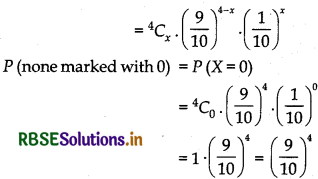
Question 7.
In an examination, 20 questions of true-false type are asked. Suppose a student tosses a fair coin to determine his answer to each question. If the coin falls heads, he answers ‘true’, if it falls tails, he answers ‘false’. Find the probability that he answers at least 12 questions correctly.
Answer:
Let X represent the number of correctly answered questions out of 20 questions.
The repeated tosses of a coin are Bernoulli trials. Since “head” on a coin represents the true answer and “tail” represents the false answer, the correctly answered questions are Bernoulli trials.
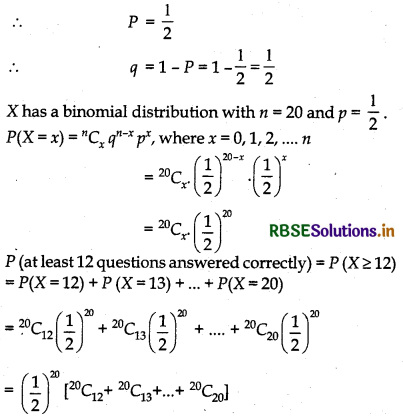
Question 8.
Suppose X has a binomial distribution B (6, \(\frac{1}{2}\)). Show that X = 3 is the most likely outcome.
(Hint: P (X = 3) is the maximum among all P (xi), xi = 0, 1, 2, 3, 4, 5, 6)
Answer:
Xis the random variable whose binomial distribution is B (6, \(\frac{1}{2}\))
Therefore, n = 6 and p = \(\frac{1}{2}\)
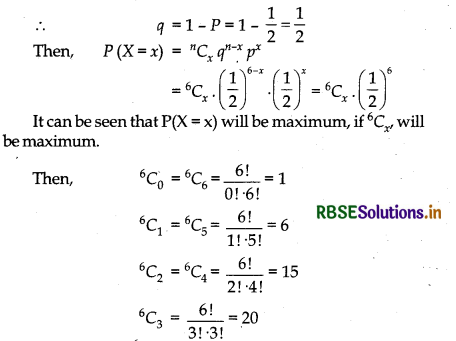
The value of 6C3 is minimum. Therefore, for x = 3, P(X = x) is maximum.
Thus, X =3 is the most likely outcome. Ans.
Question 9.
On a multiple choice examination with three possible answers for each of the five questions, what is the probability that a candidate would get four or more correct answers just by guessing?
Answer:
The repeated guessing of correct answers from multiple choice questions are Bernoulli trials. Let X represent the number of correct answers by guessing in the set of 5 multiple choice questions.
Probability of getting a correct answer is, p = \(\frac{1}{3}\)
∴ q = 1 = p = 1 - \(\frac{1}{3} = \frac{2}{3}\)
Clearly, X has a binomial distribution with n = 5 and p = \(\frac{1}{3}\).
∴ P(X = x) = nCx qn - x px
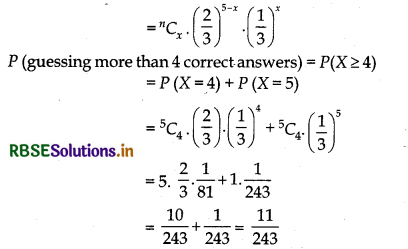
Question 10.
A person buys a lottery ticket in 50 lotteries, in each of which his chance of winning a prize is \(\frac{1}{100}\). What is the probability that he will win a prize (a) at least once (b) exactly once (c) at least twice ?
Answer:
Let X represent the number of winning prizes in 540 lotteries. The trials are Bernoulli trials.
Clearly, X has a binomial distribution with n = 50 and p = \(\frac{1}{100}\)
q = 1 - P = 1 - \(\frac{1}{100}=\frac{99}{100}\)
(a) P (winning at least once) = P (X ≥ 1)
= 1 - P(X < 1)
= 1 - P(X = 0)

(b) P (winning exactly once) = P (X = 1)
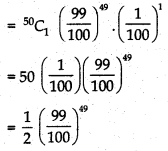
(c) P (at least twice) = P (X ≥ 2)
= 1 - P (X < 2)
= 1-P(X ≤ 1)
= 1 - [P(X = 0) + P(X = 1)]
= 1 - [P(X = 0)] - P(X = 1)
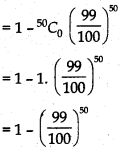

Question 11.
Find the probability of getting 5 exactly twice in 7 throws of a die. .
Answer:
The repeated tossing of a die are Bernoulli trials. Let X represent the number of times of getting 5 in 7 throws of the die Probability of getting 5 in a single throw of the dice,
p = \(\frac{1}{6}\)
q = 1 - p = 1 - \(\frac{1}{6}=\frac{5}{6}\)
Clearly, X has the probability distribution with n = 7 and p = \(\frac{1}{6}\)
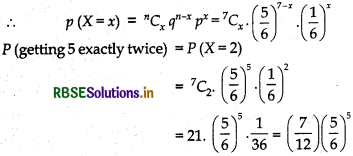
Question 12.
Find the probability of throwing at most 2 sixes in 6 throws of a single die.
Answer:
The repeated tossing of the dice are Bernoulli trials. Let X represent the number of times of getting sixes in 6 throws of the dice. Probability of getting six in a smgle throw of dice,
p = \(\frac{1}{6}\)
q = 1 - p = 1 - \(\frac{1}{6}=\frac{5}{6}\)
Clearly, X has binomial distribution with n = 6
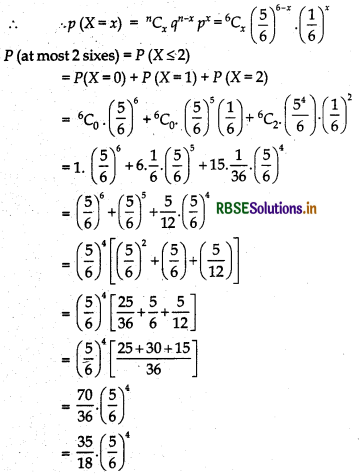
Question 13.
It is known that 10% of certain articles manuf ac-tured are defective. What is the probability that in a ran¬dom sample of 12 such articles, 9 are defective ?
Answer:
The repeated selections of articles in a random sample space are Bernoulli trials. LetX denote the number of times of selecting defective articles in a random sample space of 12 articles.
Clearly, X has a binomial distribution with n = 12 and p = 10% = \(\frac{10}{100}=\frac{1}{10}\)
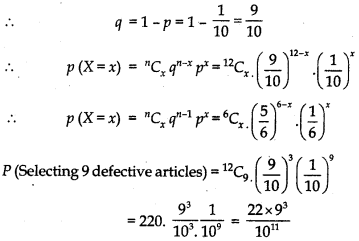
In each of the following questions choose the correct answer
Question 14.
In a box containing 100 bulbs, 10 are defective. The probability that out of a sample of 5 bulbs, none is defective, is:
(A) 10-1 (B) \(\left(\frac{1}{2}\right)^5\) (C) \(\left(\frac{9}{10}\right)^5\) (D) \frac{9}{10}
Answer:
The repeated selections of defective bulbs from a box are Bernoulli trials. Let X denote the number of defective bulbs out of a sample of 5 bulbs.
Probability of getting a defective bulb, p = \(\frac{10}{100}=\frac{1}{10}\)
q = 1 - p = 1- \(\frac{1}{10}=\frac{9}{10}\)
Clearly, X has a binomial distribution with n = 5 and P = \(\frac{1}{10}\)
P(X = x) = nCx qn-xpx = 5Cx\(\left(\frac{9}{10}\right)^{5-x} \cdot\left(\frac{1}{10}\right)^x\)
P(none of the bulbs is defective) = P(X = 0)
= 5C0\(\left(\frac{9}{10}\right)^5\) = 1 \(\left(\frac{9}{10}\right)^5=\left(\frac{9}{10}\right)^5\)
The correct answer is C.

Question 15.
The probability that a student is not a swimmer is \(\frac{1}{15}\). Then the probability that out of five students, four
(A) 5C4\(\left(\frac{4}{5}\right)^4 \frac{1}{5}\)
(B) \(\left(\frac{4}{5}\right)^4 \frac{1}{5}\)
(C) 5C1\(\frac{1}{5}\left(\frac{4}{5}\right)^4\)
(D) None of these
Answer:
The repeated selection of students who are swimmers are Bernoulli trials. Let X denote the number of students, out of 5 students, who are swimmers.
Probability of students who are not swimmers, p = \(\frac{1}{5}\)
∴ q = 1 - p = 1 - \(\frac{1}{5}=\frac{4}{5}\)
Clearly, X has a binomial distribution with
n = 1 - q = 1 - \(\frac{1}{5}=\frac{4}{5}\)
Clearly, X has a binomial distribution with n = 5 and p = \(\frac{4}{5}\)
∴ p(X = x) = nCxqn-1px = 5Cx\(\left(\frac{1}{5}\right)^{5-x} \cdot\left(\frac{4}{5}\right)^x\)
p(four students are swimmers)
= P(X = 0) = 5C4\(\left(\frac{1}{5}\right) \cdot\left(\frac{4}{5}\right)^4\)
Therefore, the correct answer is A.

- RBSE Class 12 Maths Notes Chapter 13 Probability
- RBSE Class 12 Maths Notes Chapter 12 Linear Programming
- RBSE Class 12 Maths Notes Chapter 11 Three Dimensional Geometry
- RBSE Class 12 Maths Notes Chapter 10 Vector Algebra
- RBSE Class 12 Maths Notes Chapter 9 Differential Equations
- RBSE Class 12 Maths Notes Chapter 8 Application of Integrals
- RBSE Class 12 Maths Notes Chapter 7 Integrals
- RBSE Class 12 Maths Notes Chapter 6 Application of Derivatives
- RBSE Class 12 Maths Notes Chapter 5 Continuity and Differentiability
- RBSE Class 12 Maths Notes Chapter 4 Determinants
- RBSE Class 12 Maths Notes Chapter 3 Matrices